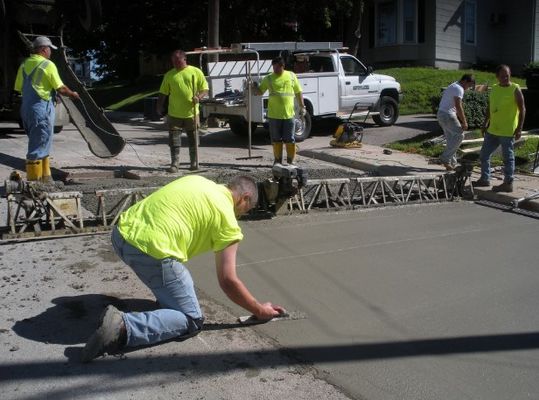What is Dry Cast Concrete?Dry cast concrete (also known as DCC) is a form of concrete that has been used in the concrete industry since the late 1800s. It was developed by concrete producers as a replacement for wet cast concrete, which is very heavy and requires more labor to transport and install. DCC has high production demands in the precast industry today because of its cost-effective and economic solution benefits. Dry cast concrete is a type of construction aggregate or stone that consists of raw materials like sand, gravel, limestone, clay, and amounts of water. It is produced by mixing these components at high heat and pouring them into forms. It is usually poured at temperatures above 100 degrees Fahrenheit. The mixture cools down and becomes solid within 30 minutes. After curing, the hardened concrete is ready to be transported to the job site. Compared to other construction aggregates, dry cast concrete is much lighter and easier to handle during the process. This means it can be moved from place to place without requiring special equipment. Because of this, DCC is often used for roads, bridges, sidewalks, parking lots, playgrounds, and other outdoor structures instead of doing the wet cast process. The Dry Tamp Method for Paver SurfacesIn addition to being lightweight, dry cast concrete is easy to work with. This makes it ideal for paver surfaces such as driveways, walkways, patios, and pool decks. Dry cast methods are so versatile that you can even use them indoors! Because dry cast concrete blocks are so lightweight, it doesn’t require any formwork when installing them on flat surfaces like driveways and patios. Instead, you simply pour the precast product directly onto the surface. Once it hardens, you can easily remove the excess using a trowel. This method works well for small projects too. For example, you can pour the concrete yourself if you need to build a few steps leading up to your front door. You can also choose your own mix designs whether you want to install a concrete pipe or concrete pavers. However, there are some drawbacks to using dry cast concrete for paving applications. First, it isn’t suitable for large-scale projects. If you want to pave a driveway or patio, you need to hire a professional contractor specializing in dry cast concrete installation. Second, it isn't as durable as other types of concrete in the industry. While it may look strong enough after curing, it won’t last long once exposed to weathering elements due to its high rate of absorption. This means you should expect to replace it every couple of years. Third, it isn't as affordable as other types of concrete products either. Although it’s cheaper than traditional concrete, it still costs more than other alternatives due to its consistent production rates from high demand. If you plan to use dry cast concrete for your next project, choose the right product for the job. Using High-Quality Products and Cementitious Materials for Dry CastingThere are two main types of cementitious materials: hydraulic cement and nonhydraulic cement. Both types contain Portland cement but differ in their chemical composition and physical properties. Hydraulic CementHydraulic cement is made of ground limestone, clay, and alumina. When mixed with water, it produces a paste that sets into a hard mass. The most commonly used hydraulic cement include portland cement, calcium sulfate hemihydrate (gypsum), and calcium carbonate. Portland cement is the most common hydraulic cement because it has excellent compressive strength, low permeability, and good corrosion resistance. However, it requires a lot of energy and is very expensive. Calcium sulfate hemihydrate (gypsum) is another popular hydraulic cement. It’s less expensive than portland cement, but it’s not nearly as strong. Its high rate of water absorption allows moisture to penetrate through it quickly. As a result, gypsum tends to crack and crumble over time. Calcium carbonate is another type of hydraulic cement. It‘s inexpensive and easy to obtain, but it lacks the compressive strength of portland cement. Nonhydraulic CementUnlike hydraulic cement, nonhydraulic cement isn’t made from mixtures of lime and clay. Instead, they're composed of natural minerals such as sand, gravel, crushed stone, and slag. They set into solid masses by reacting with water. The resulting material is usually stronger than portland cement, making it a preferred material for larger structures. The most common nonhydraulic cement is blast furnace slag, also known as silica fume. It's produced by heating iron ore at extremely high temperatures. The heat causes the iron oxide to separate from the ore and collect in the bottom of the furnace. After cooling, this mixture of iron oxide and silicon dioxide is collected and processed into a fine powder. The powder can be combined with pounds of water to form a mortar or concrete mix. It’s often used as a composite material in the construction industry to increase the durability of portland cement mixes. Other Types of ConcreteAlthough dry-cast products are primarily made up of cement and aggregate, it doesn’t have to be limited to these ingredients. You can add additional additives to improve its performance. For example, you can add fly ash, pozzolanic materials, or mineral admixture to boost the strength and reduce the cost. Fly AshFly ash is a waste product generated during coal-fired power plants. It consists of small particles of aluminum oxide and silicon dioxide. These particles react chemically when heated and become reactive aluminum hydroxide. Fly ash adds strength and reduces shrinkage to concrete. PozzolansPozzolans are naturally occurring materials that expand when exposed to water. They replace some of the cement in the concrete mix and make it more durable. Common pozzolans include volcanic ash, pumice, and metakaolin. Mineral AdmixturesMineral admixtures are substances added to concrete to enhance its properties. Some examples include: • Alkali Silicates – These compounds help prevent cracking due to expansion and contraction. • Calcite – This substance helps strengthen concrete by increasing its hardness. • Gypsum – This compound increases the strength of concrete by absorbing excess water. • Lime – This chemical reacts with other chemicals in concrete to create a hardened surface. • Portland Cement – This ingredient improves the strength of concrete by creating a hard outer layer. How To Make Dry Tamp Cast Stones1. Mixing Materials Mixing materials is one of the first steps in the making of dry tamp cast stones. There are two types of mixing equipment available: hand tools and machines. Hand tools are best suited for small projects like garden beds. Machines are better suited for large jobs like driveways and sidewalks. Hand Tools A shovel is the simplest tool to use. Simply fill your bucket halfway with sand or gravel, and then pour the rest of the mixture onto the top. Use your hands to stir the mixture until it becomes homogenous. A trowel is another simple tool to use. Fill your bucket halfway with sand or gravel, and then add the remaining mixture. Stir the mixture thoroughly using your hands. A rake is useful for spreading the mixture evenly across a flat area. Place your bucket on a level surface and spread the mixture with a rake. A wheelbarrow is ideal for moving material around a job site. Load your bucket halfway with gravel or sand, and then pour the remainder of the mixture into the bucket. 2. Choosing a Mixture Once you've mixed all the components, you must choose between wet and dry mixes. Wet mixes contain water and require an extra step to cure before they can be used. Dry mixes don't require any curing time. However, they require more effort to prepare because you must remove the water from the mixture. 3. Pouring Concrete Once you've chosen which type of mix you want to use, you'll need to decide where to pour the concrete and what design you want for it. You have several options, including: • Driveway – Pour the concrete directly over the ground. • Sidewalk – Pour the concrete along the edge of the sidewalk. • Garden Beds – Pour the concrete into the center of the bed. 4. Setting Up Your Work Area Before pouring concrete, set up your work area. If you plan to pour concrete outside, you'll need to protect yourself from splashing concrete. Wear long pants, closed-toed shoes, and gloves. Also, wear goggles if you plan to pour concrete near trees or plants. 5. Preparing the Site Prepare the site by removing weeds, grass, and debris. Remove rocks and roots from the soil. Then dig holes for each stone. The size of these holes will determine how big the finished stones will be. 6. Adding Water Add water to the mixture according to the manufacturer's instructions. Add enough water so that the mixture has the consistency of peanut butter. 7. Placing the Stone Place the stones in their respective holes. Press down firmly as you place them. Once all the stones are placed, smooth out the tops of the stones with your fingers. 8. Curing Time Cure the concrete for at least 24 hours. This allows the cement to harden and form a bond with the surrounding soil. After this period, the concrete should be ready for finishing. 9. Surface Finishes Finish the concrete by adding additional aggregate (sand) to the top layer of concrete. Smooth out the top layer with a trowel. Let the concrete cure for at least one week before walking on it. Does Waste Glass Powder Really Enhance Concrete?Glass powder is often added to concrete to enhance its appearance. It also helps prevent cracking and gives concrete strength. But does glass really make concrete stronger?
The answer depends on what kind of concrete you’re talking about. There are two types of concrete: Portland cement concrete and non-Portland cement concrete. Both types of concrete contain cement, but only Portland cement concrete contains fly ash, silica fume, and other additives. These materials give Portland cement concrete its unique properties.
3 Comments
9/19/2022 09:45:20 pm
This is awesome, dry cast concrete is a great option for those looking for a durable and long-lasting concrete option. This type of concrete is typically used in commercial and industrial applications due to its high strength and low absorption rate.
Reply
11/18/2022 12:48:22 am
Dry cast concrete is a process whereby the mix is poured into a form and allowed to dry, cast-in-place concrete is the same, except that the concrete is placed and dried in the form simultaneously. If a curing compound is used, the two terms are used interchangeably. Concrete is made up of water, aggregate and cement. Water makes up approximately one-half of the weight of the concrete. Cement makes up approximately 28% of the total weight. The amount of water and the type of aggregate used determines the strength of the concrete. Of the three materials, the amount of cement used is the critical factor that determines the strength and durability of the concrete.
Reply
5/3/2024 06:06:34 am
Dry cast concrete is a specialized form of concrete manufacturing where minimal water is used in the mix, resulting in a stiff, dry consistency. This method relies on the use of low-slump concrete, which means it holds its shape without the need for excessive water content.
Reply
Leave a Reply. |
|

